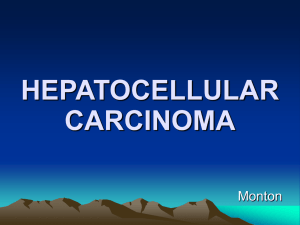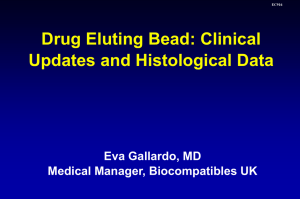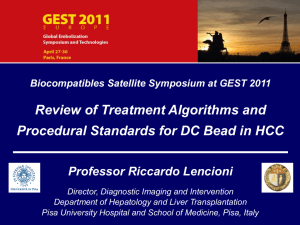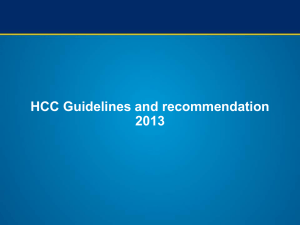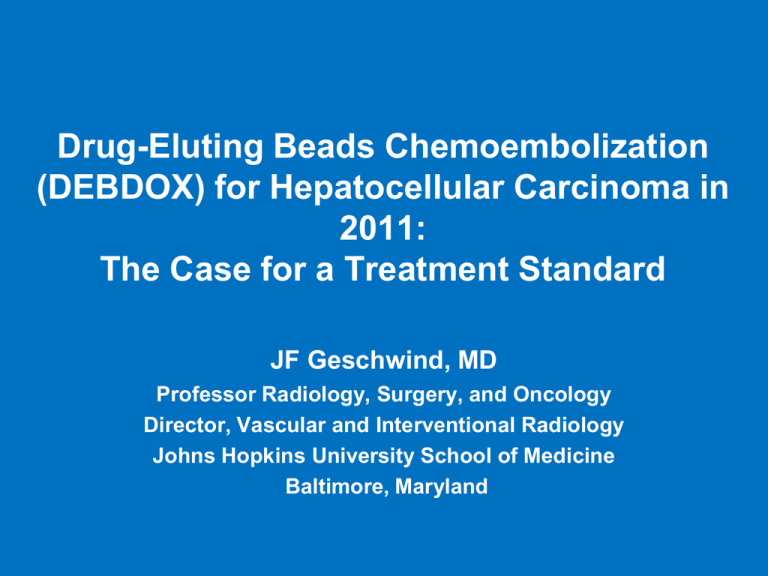
Drug-Eluting Beads Chemoembolization
(DEBDOX) for Hepatocellular Carcinoma in
2011:
The Case for a Treatment Standard
JF Geschwind, MD
Professor Radiology, Surgery, and Oncology
Director, Vascular and Interventional Radiology
Johns Hopkins University School of Medicine
Baltimore, Maryland
1
1. Why Drug-elutingTechnology?
Clear Rationale:
1. Maximize drug delivery
2. Consistent (scientifically reproducible)
3. Long lasting effect/slow release
(sustained)
4. Tumor effect vs. systemic side effects
WE HAVE COME A LONG WAY!
2
BCLC staging system and
treatment strategy
HCC
Stage 0
Stage A–C
Stage D
PS 0, Child–Pugh A
PS 0–2, Child–Pugh A–B
PS >2, Child–Pugh C
Very early stage (0)
Early stage (A)
1 HCC <2cm
Carcinoma in situ
1 HCC or 3 nodules
<3cm, PST 0
Portal pressure/
bilirubin
Increased
Resection
Multinodular,
PST 0
Portal invasion,
N1, M1, PST 1–2
3 nodules ≤3cm
1 HCC
Normal
Intermediate stage (B) Advanced stage (C) End stage (D)
Associated diseases
No
Liver transplantation
Curative treatments
Yes
PEI/RFA
TACE
Sorafenib
Randomised controlled trials
HCC = hepatocellular carcinoma; BCLC = Barcelona Clinic Liver Cancer
PEI = percutaneous ethanol injection; RFA = radiofrequency ablation
TACE = transarterial chemoembolisation; PST = performance status
Symptomatic
treatment
Llovet JM, et al.
J Natl Cancer Inst 2008;100:698–711
3
Chemoembolization of Hepatocellular Carcinoma With
Drug-Eluting Beads: Efficacy and Doxorubicin
Pharmacokinetics
27 patients with
Child-Pugh A
Response rate
assessed by CT at
6 months
Doxorubicin at serum, ng/mL
1000
800
600
400
200
0
Response rate: 75%
Time Post-Procedure
Doxorubicin at serum, ng/mL
1- and 2-year
survival: 92% and
89% (median followup of 28 months)
DEB-TACE
1000
Conventional TACE
800
600
400
200
DEBDOX: DC Bead®, Drug-Eluting Bead doxorubicin
Varela M et al. J Hepatology. 2006; 46(3):474-481.
0
Time Post-Procedure
4
Single Center Phase II Trial of DEBDOX in
Patients with Unresectable HCC
Variable
Value
Number patients enrolled
20
Mean age, years (range)
64 (41-85)
Sex (M/F)
12/8
Child-Pugh (A/B/C)
15/5/0
BCLC (B/C)
8/12
ECOG (0/1/2)
9/10/1
Hepatitis B/C/other
5/8/7
Mean tumor size in cm (range)
6.9 (1.9-16.2)
Number Tumors (1,1+,
Multifocal)
10/6/4
Portal vein thrombosis (Y/N)
4/16
AFP (ng/ml)
1215
Reyes D et al. Cancer J. 20095
Kaplan-Meier Survival Curves
Survival Probability %
100
OS
PFS
80
60
40
20
0
0
10
20
30
Time Months
40
6
Reyes D et al. Cancer J. 2009
PRECISION V:
Overall 6-month Tumor Response Rates
p = 0.11
Disease Control = Objective Response + Stable Disease Objective Response = Complete Response + Partial Response
7
6-month Response in More
Advanced Patients
DC Bead® demonstrated statistically significant advantage in advanced patients
Objective Response (p=0.038) and Disease Control (p=0.026)
P < 0.05
8
Incidence of doxorubicin-related AEs (%)
PRECISION V trial1: DC Bead® was associated with
a significantly lower incidence of doxorubicin-related
AEs than cTACE
DC Bead® cTACE
35
Alopecia
Marrow suppression
Mucositis
Skin discoloration
30
25
p=0.012*
20
15
10
5
0
DC Bead®
cTACE
*p=0.0001 for analysis with assumption of independence of events
AE = adverse event
DC Bead® is approved in 40
countries worldwide, including the
USA (as LC Bead™) and Europe2
1. Lammer J, et al. Cardiovasc Intervent Radiol 2010;44:41–52
2. http://www.biocompatibles.com/media/press-releases/2009/06-08-2009.aspx
9
Prospective Randomized Comparison of Chemoembolization with
Doxorubicin-Eluting Beads and Bland Embolization with Bead
Block for Hepatocellular Carcinoma Malagari et al, Cardiovasc Intervent Radiol. 2009 Nov 24
• Evaluate the added role of a
chemotherapeutic in TACE of
intermediate-stage HCC
• Group A (n = 41) DEBDOX
• Group B (n = 43) bland embolization
• EASL criteria and AFP
• At 6 month:
DEBDOX CR 27% PR 46%
Bland embo CR 14% PR 42%
• Tumor Recurrence:
Bland embolization >> DEBDOX
(78% vs. 46% at 12 months)
• TTP: DEBDOX >>Bland embolization
42 +/- 9.5 vs. 36 +/- 9.0 weeks,
p = 0.008
10
Clinical Evidence
Investigator
Level of
evidence
Number
patients
CP score
CR and PR
Survival *
Varela (2007)
3iiDiii
27
A
75% (EASL)
2YR 89%
Geschwind (2009)
3iiiDiii
20
A(15)/B(5)
89% (RECIST)
95% (EASL)
26 months
Poon (2007)
3iiDiii
35
A
50% (RECIST)
70% (EASL)
N/A
Grosso (2008)
3iiiDiii
50
A(46)/B (4)
74.8 % (EASL)
N/A
Malagari (2008)
3iiDiii
71
A (27)/B (44)
80.6 % (EASL)
2YR 91%
27
A
50% (RECIST)
N/A
Forner (2008)
Lammer (2008)
3iiDiii
30
A (26)/B (4)
40% (RECIST)
44% (EASL)
N/A
LencioniPRECISION V
(2010)
1iiDiii
212 (102
DEB)
A (77)/B (16)
52% (RECIST)
63% (EASL)
N/A
*Survival data on DEBDOX are restricted to less than 4 years and longer term follow-up results will be published soon.
**DEB vs TACE: p=0.11. DEB advantage for CP B/ECOG 1/bilobar or recurrence: p= 0.038. Fewer dox side effects: p=0.000111
Conclusions
DEBDOX: Proven Rationale
Extension of cTACE
Excellent PK profile
Minimal toxicities
Efficacy: Tumor response 75-85% EASL
Survival: ~26 months BCLC B-C
12
2. How?
Technical Considerations:
Towards a Standardized Protocol
Drug delivery not embolotherapy!
1. Choice of particle size
2. Choice of drug: doxorubicin vs. irinotecan
3. Catheter placement
4. Actual delivery (how? Contrast or not?)
5. End point (?)
13
1.
Optimizing Drug Delivery:
Importance of Particle Size
14
IA Therapy for Vx-2 Liver
Tumor:
Iron-oxide Labeled
Microspheres 300-500µm
Distribution of iron oxide-containing
Embosphere particles after transcatheter
arterial embolization in an animal model of
liver cancer: evaluation with MR imaging and
implication for therapy.
Lee KH, Liapi E, Vossen JA, Buijs M,
Ventura VP, Georgiades C, Hong K, Kamel I,
Torbenson MS, Geschwind JF. J Vasc Interv
Radiol. 2008 Oct;19(10):1490-6.
15
IA Therapy for Vx-2 Liver
Tumor:
Iron-oxide Labeled
Microspheres 100-300µm
16
Drug-Eluting Beads for liver embolization: Concentration
of doxorubicin in tissue and in beads in a pig model
100-300μm or 700-900μm loaded with 37.5 mg dox/mL
Livers analyzed 28 or 90 days after embolization
DEBs eluted 43% of their initial drug load after 28 days and
89% after 90 days
Drug detected at distances as far as 600μm from bead
edge
100-300μm induced more necrosis than 700-900μm
beads (p= .0036)
MicroCT analysis: Small beads distal arteries +
homogeneous distribution
Doxorubicin concentration declines with increasing distances
from the bead edge (still enough to be cytotoxic in vitro)
Namur J et al. J Vasc Interv Radiol. 2010 Feb;21(2):259-67
Dreher M et al. GEST 2010
17
1.
Optimizing Drug Delivery:
Importance of Particle Size
SMALL
18
DC Bead® [DEBDOX] in Patients with HCC
Complete necrosis on MR imaging
19
Histological findings and tumor response
48 y/o female, right lobe lesion,
s/p 3 treatments with DEBDOX
Gross specimen after resection showing complete necrosis
20
Histopathology: Extensive necrosis +
no viable tumor cells
DEB within necrotic tumor
21
2.
Optimizing Drug Delivery:
What drug?
Doxorubicin: HCC, NET
Irinotecan: CRC (?), No data
22
3.
Catheter Placement
Selective?
YES
1.Better control
2.Minimize reflux
3.Better visualization of beads
23
65 yo woman Child B with large HCC: First Treatment
24
Pre-treatment
Post-treatment #1: Residual viable tumor
25
Second Treatment
26
MRI Post-treatment #2
No recurrence 29 months post initial treatment
27
4.
Actual Delivery
1. Must use microcatheter
2. Use cone beam CT for targeting
3. Visibility of beads critical
4. Mix with contrast (4:1)
5. Inject slowly (1 ml/min)
28
Usefulness of Cone Beam CT
Imaging: Research and Clinical Use
1. Visualize the tumor
2. Target the tumor (drug delivery)
3. Proof of success = predicting response:
Tumor perfusion
Tumor segmentation
29
DEBDOX in Patient with HCC:
Usefulness of Cone Beam CT
30
5.
End Points
1. Entire planned dose administered
2. Stop before stasis!!
3. No need for further bland embolization
31
Conclusions
Drug-Eluting Beads in 2011: Why, how and when?
WHY? Rationale ESTABLISHED
HOW? Technical considerations NEARING CONSENSUS
(panel of experts)
Bead size: Nearly there! SMALL >>large
Drug: Doxorubicin (YES) vs. irinotecan (NO)
Catheter position: SELECTIVE
End point: FULL DOSE (no stasis)
Unknown: Frequency treatment/dosing
WHEN? HCC: Good data
NET: On-going studies, CRC: On-going studies
32
DISCLOSURES
Grant support:
Genentech, Bayer Healthcare, Nordion,
Biocompatibles, Abdulmalik Research Fund, Alice
Pratt Liver Cancer Fund, NIH/NCI, DOD, RSNA, SIR
Consultant:
Philips Medical System, Bayer Healthcare,
Nordion, Biocompatibles, Guerbet, PreScience
Patent:
Use of 3-BrPA as an anti-cancer agent
Founder: PreScience Pharma
33

